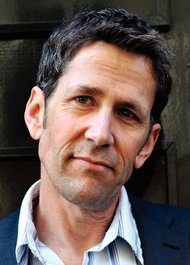Don Gehrmann may be the best American miler you’ve never heard of. Between 1949 and 1952, the runner from Milwaukee’s south side won 39 consecutive national and international mile races, including the famous Wannamaker Mile in New York. After winning the 1500 and setting the world record in the 1000 in the 1952 British games, Gehrmann was approached by an event official at lunch. The American quarter-miler was injured; would Gehrmann fill in?
“I said, ‘Well, I’m eating hamburgers and hot dogs, and I’m full of food,’” Gehrmann recalled earlier this year. “He said, ‘You’ve got a half-hour before you have to run.’”
Gehrmann ran. He beat the quarter-milers, handily.
The difference between writing a novel and writing a short story is often compared to the difference between running a marathon and a sprint. And if there’s any writer today likely to pull a Gehrmann and lap the competition after eating hamburgers and hot dogs, it’s Jess Walter.
Literarily speaking, he’s done it regularly in the last decade. In 2005, his Citizen Vince won the coveted Edgar prize for mystery fiction. The next year, Walter’s post-9/11 novel The Zero was a finalist for the National Book Award. Last year, his silver-screen saga Beautiful Ruins bowled over both critics and book clubs. Walter seems able to reinvent himself with each book he writes, effortlessly.
The thirteen stories in We Live in Water, Walter’s first story collection, represent another event for Walter. But here, the effort seems more noticeable, and some of these stories read more like heats, exercises in preparation for some fuller event.
Walter’s signature strengths are all on display here: his knack for zeroing in on a character’s buttons and then pushing them. His uncanny sense of the plot twist (a homeless man resorts to asking for handouts on a street corner to buy his kid the latest Harry Potter book, but when his son’s foster family won’t accept it, he ends up reading the book himself on that same street corner.) A former reporter, Walter has coined a cool, just-the-facts-ma’am treatment of characters down in the count who just to seem to keep hitting out after out.
But in many of these stories, that desperation doesn’t get time to seethe. These down-on-their-luck fathers, sons and crooks move from deep to deeper trouble in not much space, and the absent women and broken promises haunting the men in these stories are rarely given the space to haunt us, too.
A series of two- to five-page linked stories about a group of men who work at a body shop in Spokane—“Can a Corn,” “Please,” and “The Brakes”—come and go so quickly that a reader has a hard time keeping track of the characters, and the drama in them isn’t heavy enough to haunt us in the pages between. To mix my sports metaphors, the race is over and we’re still looking for our guy.
The final story, first published in McSweeney’s, is entitled “Statistical Abstract for my Hometown of Spokane, Washington.” Composed as a numbered list, it’s an interesting piece to close this book because it serves as a sort of key, anchoring in autobiography many of the images, characters and events that haunt these stories—the streets of Spokane, the “inordinate number of halfway houses, shelters, group-homes, and drug- and alcohol-rehab centers” in Walter’s neighborhood. Even the particular episode of volunteerism depicted in “Wolf and the Wild” appears here.

But “Statistical Abstract” is also intriguing because it offers a key to reading these stories: each as its own abstract, or sketch. A sketchbook is a particular pleasure: it can reveal an artist’s preoccupations, germs of ideas that get worked out in other places. And for fans of Walter’s work, the pleasures abound: We see the interest in the criminal mind that powers Citizen Vince in “Helpless Little Things” and “Virgo.” The social observer and satirist of Financial Lives of the Poets are front and center “Don’t Eat Cat” and “Anything Helps.” In “We Live in Water,” a pilgrimage for answers to the past calls to mind Beautiful Ruins. And everywhere Walter’s keen reporter’s gaze always looking for that sentence that will sum up and distill down: “Another part of it’s unifying urban theory is sprinklers, that you can gauge a neighbor’s wealth by the way people water.”
But sketches and abstracts are, finally, a shorthand form. They prize efficiency, speed and information over complication, metaphor, and catharsis. In many of these stories, the reader feels such shorthanding, such as the close of “The Brakes” between a father and a son who goes unnamed:
“—You know it don’t matter who your mom marries, right? I ain’t going nowhere. The kid looked up. He offered his dad some popcorn.”
When Walter lets the emotional pressure build under the surface long enough, the reveal is just right, such as in “The New Frontier,” when a man catches on too late to the real reason his friend has brought him along to Las Vegas to find his stepsister.
But We Live in Water also bears the marks of less understandable sketch-like qualities. As the stories race by–thirteen in just 177 pages–several unrelated main characters share names. The Wayne of “Anything Helps” seems unrelated to the Wayne in “Thief”; Julie first appears as a woman who ODs, leaving behind a son and husband (“Anything Helps”), and later as a waifish teen that joins a Greenpeace collection scam (“Helpless Little Things”). Such recycling, along with the presence of three different dialogue formats, is disorienting, and I’m not sure to what end.
George Saunders, whose stories share some situational DNA with Walter’s, recently described the difference between a novel and a short story as the difference between taking a week-long train trip with someone and having three minutes to declare your intentions before she gets on the train.
That clock is very much ticking in these stories, sometimes audibly. Here’s the opening of “Wolf and the Wild,” a story about a white-collar criminal who gets involved in an after-school tutoring program as part of his community service:
They fanned out in the brown grass along Highway 2 like geese in a loose V, eight men in white overalls and orange vests, picking up trash. In the center, in the hump between lanes, Wade McAdams found himself explaining futures trading to a drug dealer Ricky.
Setting: check. Character milieu: check. Our Main Guy: check. Secondary character with occupation: check, check.
In Citizen Vince, Walter uses a similar clipped dossier style to great effect: “About Vince Camden: he is thirty-six and white. Single. Six feet tall, 160 pounds, broad-shouldered and thin, like a martini glass.” This works perfectly in a potboiler: the reader gets what she needs, and we get down to business. But a short story is a different event, one whose impulsion comes, at least partially, from mystery: mystery of relation, or language, or human longing. So to find out what Wade’s in for and that Ricky is a drug dealer in the first paragraph feels a little like someone breaking out of the gate too fast: a reader may wonder what he’ll have saved for the end.
The best moments in this collection happen when Walter stops watching the clock—forgets that he’s a miler running the 100-yard dash—and let’s the flawed, hungering people in these pages unravel themselves at their own pace. Here’s the opening of the title story:
Oren Dessens leaned forward as he drove, perched on the wheel, cigarette in the corner of his mouth, open can of beer between his knees. He’d come apart before, of course, a couple three times, maybe more, depending on how you counted.
Which times? And that phrase: Come apart. The mysteries in these two sentences open like seams as we’re led slowly into the heart of the trouble. And trouble, after all, is Walter’s signature event.




